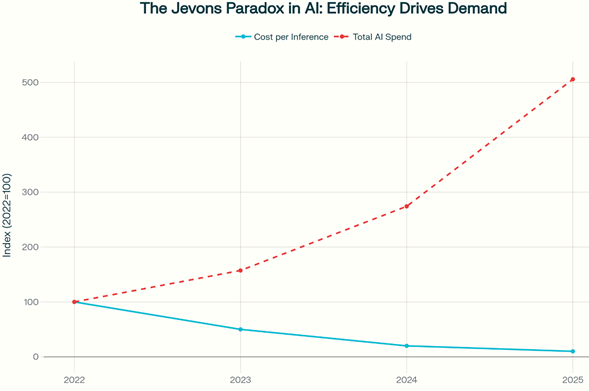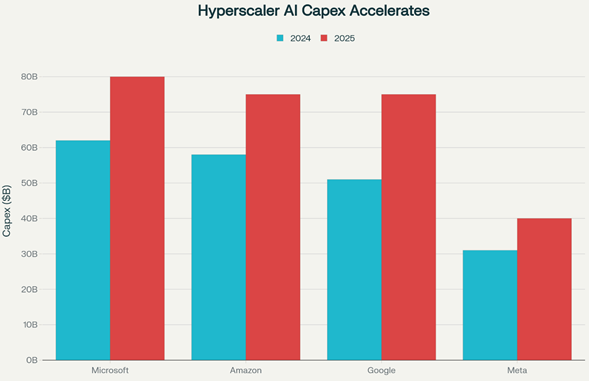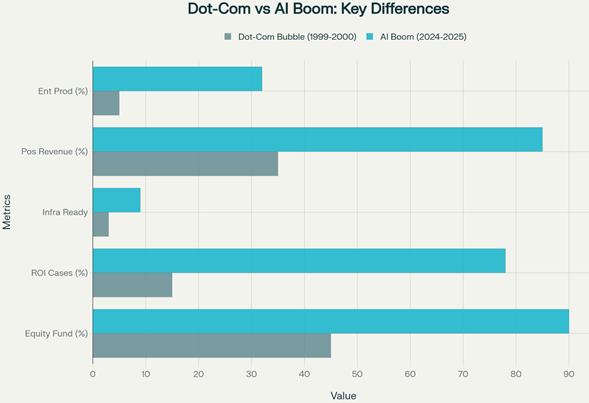US stock futures inch lower after Wall St marks fresh records on tech gains
For months, investors have asked a familiar question: Is artificial intelligence experiencing a bubble destined for the same catastrophic fate as the dot-com crash of 2000? With hyperscaler capital expenditure surging past $320 billion annually and AI stocks commanding valuations that eclipse even the TMT (Telecom, Media, and Technology) bubble peaks, the parallels seem undeniable.
Yet beneath the surface, critical differences suggest today’s AI surge may follow a fundamentally different trajectory than its predecessors.
1. A Stronger Foundation Than 1999
In the late 1990s, many internet business models depended on infrastructure that didn’t exist yet. Dial‑up connections were slow, cloud computing was nascent, and the digital “plumbing” couldn’t carry the weight of ambitious plans.
Today’s AI build‑out sits on top of mature cloud platforms, specialized chips, and global high‑bandwidth networks. Crucially, AI capabilities are visible and deployable now, from copilots in software development to quality control in manufacturing. These are production use cases that move beyond hypotheticals. That maturity lowers execution risk.
The difference shows up in throughput and tooling. Hyperscaler data centers now run specialized accelerators at a global scale, with low‑latency interconnects and production‑grade MLOps. Companies can prototype, iterate, and ship AI features within standard release cycles, not multi‑year bets on unproven infrastructure. That enables more measured, ROI‑focused adoption than the build‑it‑and‑hope model common in the late 1990s.
2. Real Revenue, Not Just ’Eyeballs’
One hallmark of the dot‑com era was the focus on vanity metrics over earnings. In this cycle, enterprises are deploying AI to cut costs and speed up work. Studies and early rollouts point to double‑digit productivity gains for developers, with a meaningful share of production code now assisted by AI. Case studies from large companies, including logistics optimization in retail, defect detection in autos, and document processing in finance, show measurable outcomes.
Spending patterns reflect that shift. Enterprise AI investment has been expanding steadily, and independent estimates from industry and consulting firms suggest large potential economic value as adoption broadens. While those forecasts will be debated, the direction of travel toward demonstrable ROI is clear.
Early data points help frame the scale. Some enterprise studies have reported roughly 31.8% productivity gains for developers using AI copilots, with user satisfaction rates above 80%. Among top adopters, code volume increased materially, and AI‑assisted code now accounts for a significant share of output. Outside software, operations teams report concrete wins: retailers citing logistics savings, automakers measuring lower defect rates, and banks accelerating document review, incremental improvements that add up at scale.
Aggregate spending is as follows. Industry trackers peg enterprise AI outlays in the hundreds of billions of dollars in 2024, with forecasts pointing higher as pilots move to production. Broader analyses estimate a multi‑trillion‑dollar annual value creation potential once adoption diffuses across functions. The range is wide, and outcomes remain uncertain, but results align with early case studies.
3. Efficiency That Fuels, Not Kills, Demand
AI is getting cheaper to run and build. Training costs for competitive models have fallen sharply, and new architectures are lowering inference costs. In many markets, falling unit costs reduce revenues. In AI, lower prices have coincided with faster growth in usage.
This pattern aligns with the Jevons Paradox, a concept economists observed in energy markets during the Industrial Revolution. Recent industry tallies show AI server and storage revenues hitting record highs while per‑unit costs decline. Lower barriers to experimentation have pulled more developers and companies into the market, expanding the total pie.
The response from the largest platforms supports this point. After efficiency gains, major cloud providers raised their AI infrastructure budgets, signaling expectations of sustained demand.
Overall, spending on computing has grown. Industry reports tallied AI server and storage revenues of around $244 billion in 2024, up from roughly $89 billion in 2023, a period that coincided with lower unit costs. Enterprise AI spending is projected to continue rising, and developer adoption surveys show a majority of organizations now experimenting with AI tools, up from a minority just two years earlier. Efficiency appears to expand the addressable market.
The Jevons Paradox in AI: As inference costs dropped 90% from 2022 to 2025, total AI spending surged over 400%.
4. A Strategic Backstop: Big Balance Sheets and Policy Priority
Who is doing the spending matters, and so does the motivation. Today’s leading investors in AI are mega‑cap tech companies with strong cash flows and diversified businesses. That reduces financing risk compared with debt‑fueled booms.
Policy also matters. The U.S. and China view AI leadership as a strategic priority, which supports continued investment through market cycles. While that doesn’t eliminate commercial risk for individual companies, it does create a wider floor for the ecosystem than earlier tech booms.
Budget intentions reflect that strategic lens. Following notable efficiency gains, large platforms outlined increased infrastructure plans for 2025, with combined guidance well above $300 billion across cloud and AI build‑outs. The investments are generally equity‑funded from substantial cash flows, which lowers systemic risk. Market commentators note that even missteps by individual firms would likely be absorbed within diversified businesses, reducing the odds of a sector‑wide crunch.
Hyperscaler AI Infrastructure Spending Accelerates: 2024 vs 2025 capital expenditure (Capex) across the four major hyperscalers (Microsoft, Amazon, Google, Meta). Total spending is increasing from $202B to $270B, a 34% year-over-year jump.
What Could Still Go Wrong
None of this guarantees a smooth path. History suggests periods of overbuild, pricing pressure, and shakeouts as competition intensifies. Key risks include:
- Pricing compression in AI services as supply scales
- Slower‑than‑expected enterprise adoption beyond early use cases
- Regulatory shifts around data, privacy, and model accountability
- Model performance plateaus that delay new applications
Additional watch‑items: supply chains for advanced chips; power and cooling constraints as data center density rises; talent bottlenecks in AI safety, reliability, and tooling; and the possibility of commoditization in undifferentiated application layers. Competition between closed and open‑source models could pressure margins, and geopolitics, from export controls to data‑sovereignty rules, may alter the cost curve and go‑to‑market plans.
How Investors Are Approaching It
Many investors aim to balance opportunity and risk. Strategies include:
- Focus on companies showing clear ROI and adoption, not just AI branding
- Diversify across the value chain, including chips, infrastructure, software, and “picks‑and‑shovels” suppliers
- Track enterprise deployment rates and capex as leading indicators of durable demand
- Maintain portfolio ballast in lower‑correlation areas in case of a tech pullback
- Options strategies like protective puts on AI-heavy indices or technology sector ETFs can limit downside while preserving upside participation.

Dot-Com Bubble vs AI Boom: 32% productivity gains vs 5%, 85% revenue-positive companies vs 35%, 9/10 infrastructure readiness vs 3/10, 78% measurable ROI vs 15%, and 90% equity funding vs 45%.
What to Watch Next
Several catalysts could shape the next leg of the cycle:
- Enterprise surveys signaling broader production rollouts beyond developer tools
- Breakthroughs that improve latency and cost at the edge
- Power‑efficiency gains from new chip designs or software sparsity
- Clarifying rules on data usage, model liability, and safety benchmarks
- Capital spending updates from major cloud providers and key suppliers
Current Outlook
The AI boom shares surface similarities with past bubbles, including fast‑rising valuations and intense attention, while the underlying conditions differ in important ways: mature infrastructure, visible productivity gains, efficiency that expands demand, and institutional support.
Corrections are possible, and weaker players are likely to be winnowed out. The foundations suggest today’s cycle may endure longer and prove more consequential than a simple bubble analogy implies.
